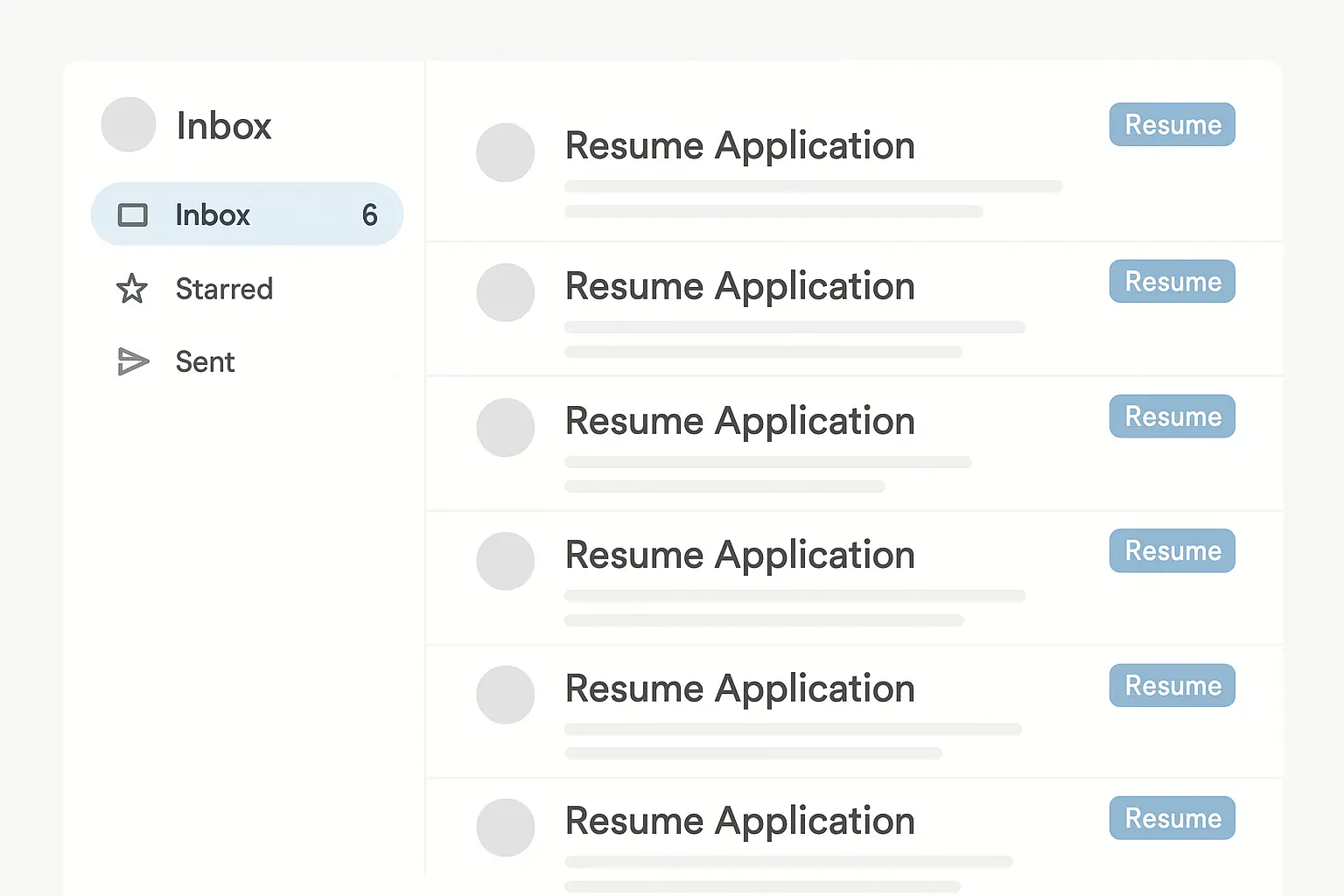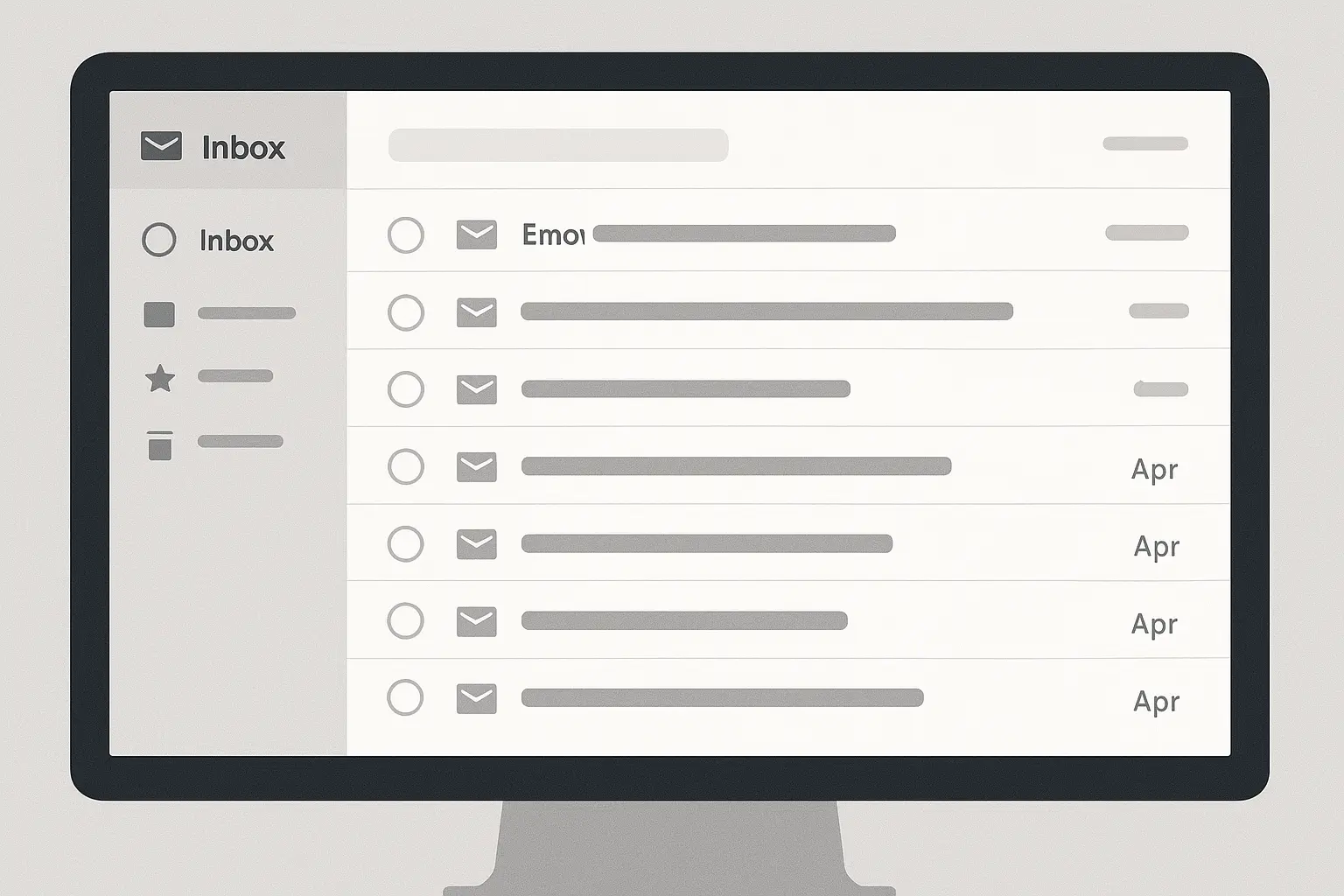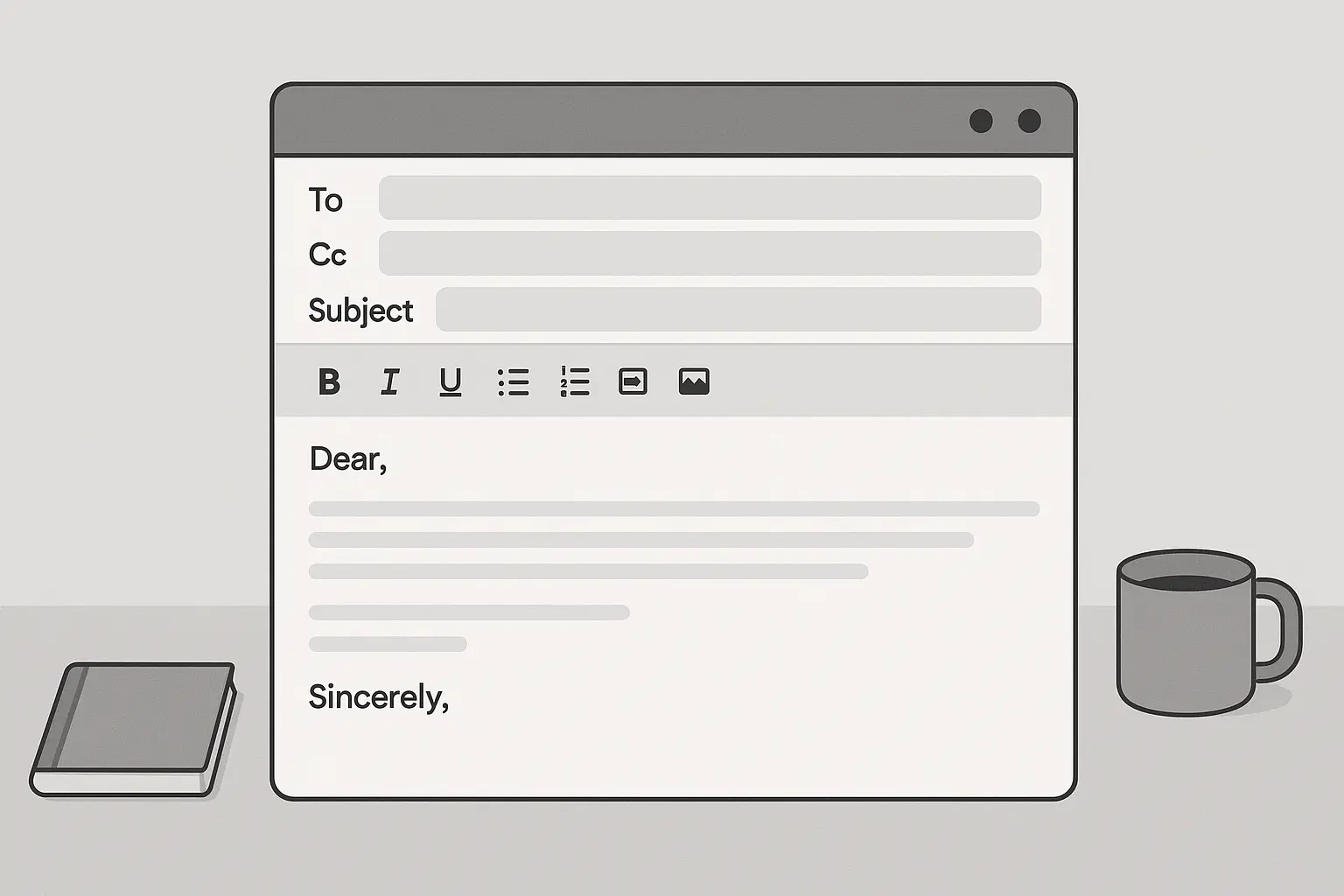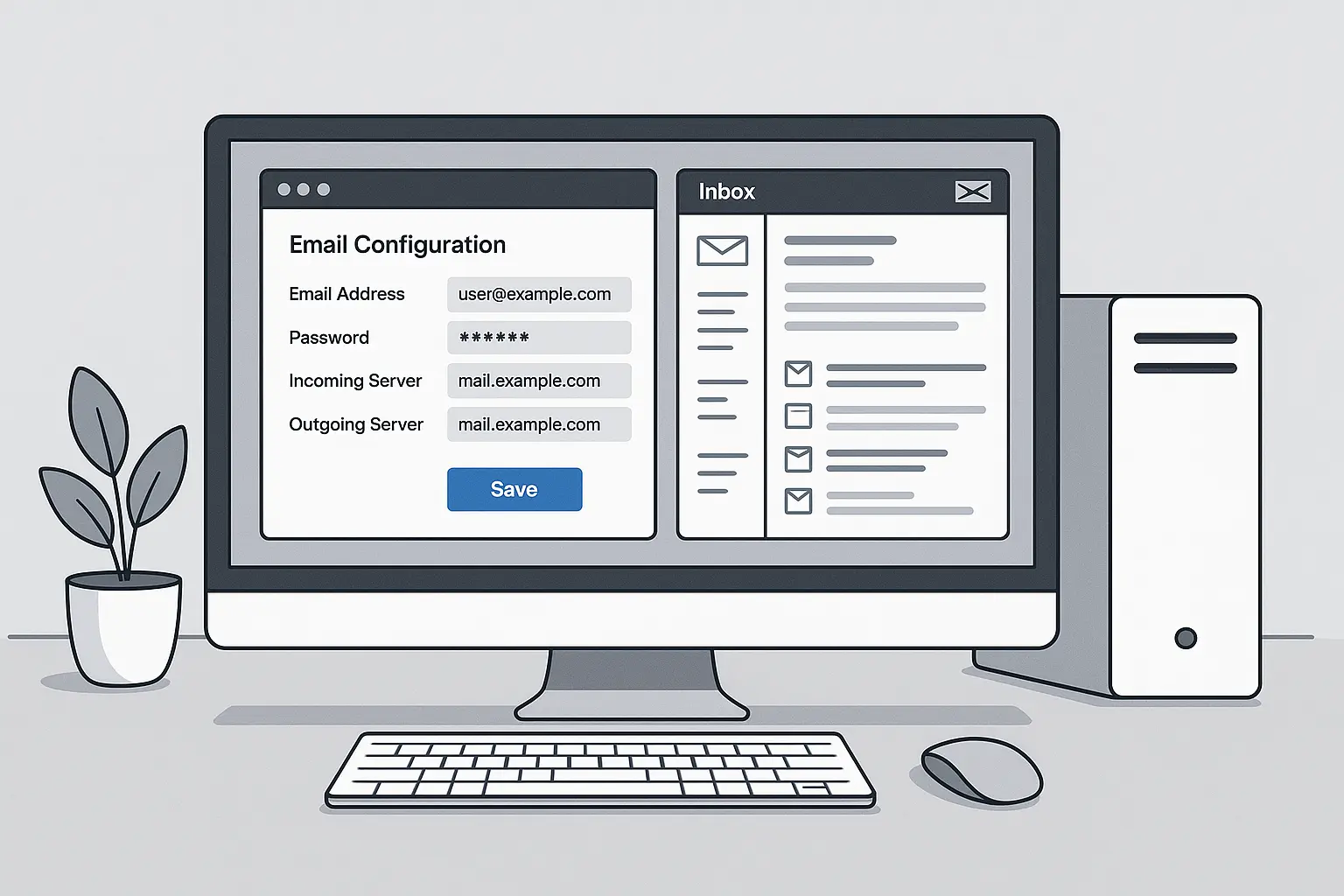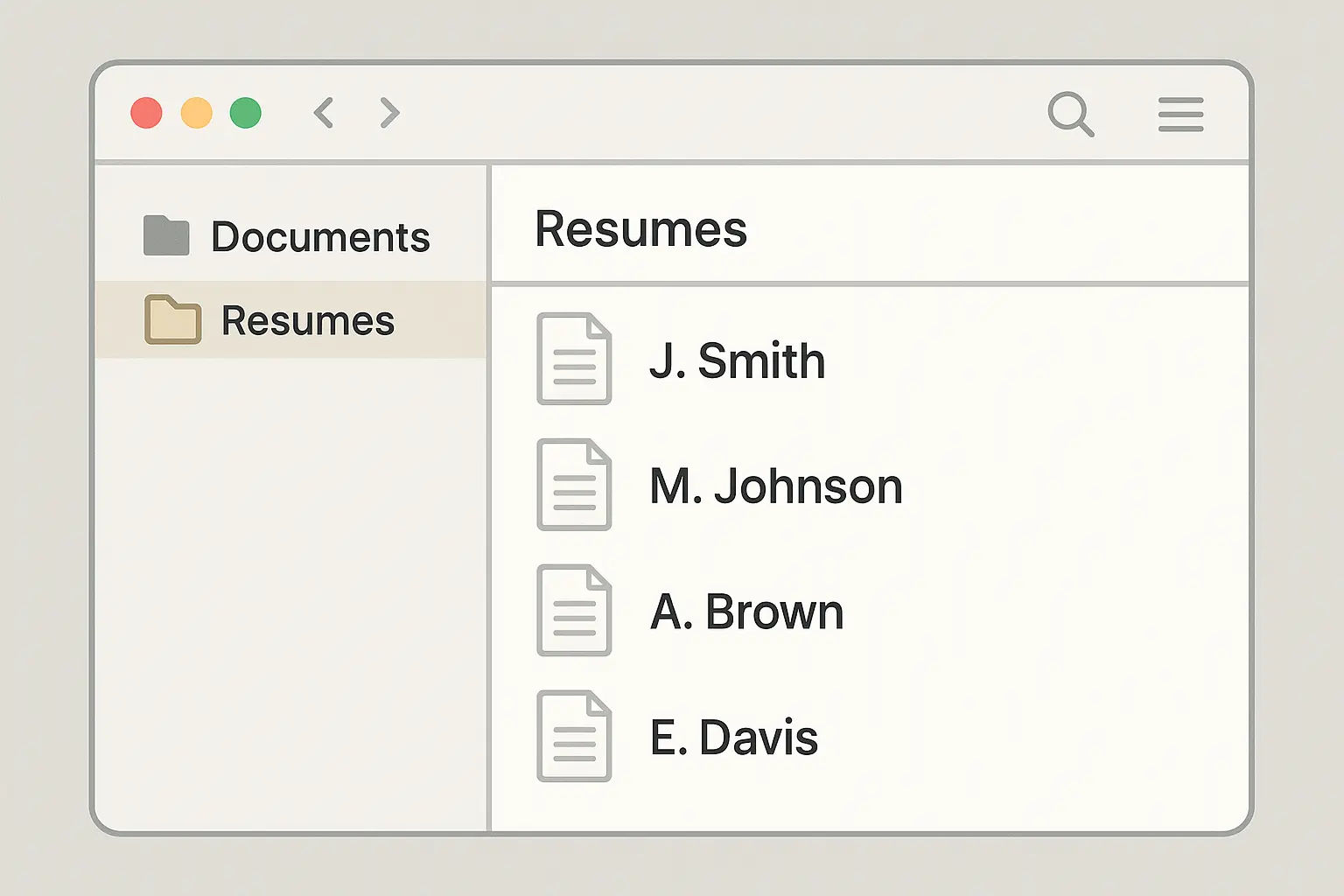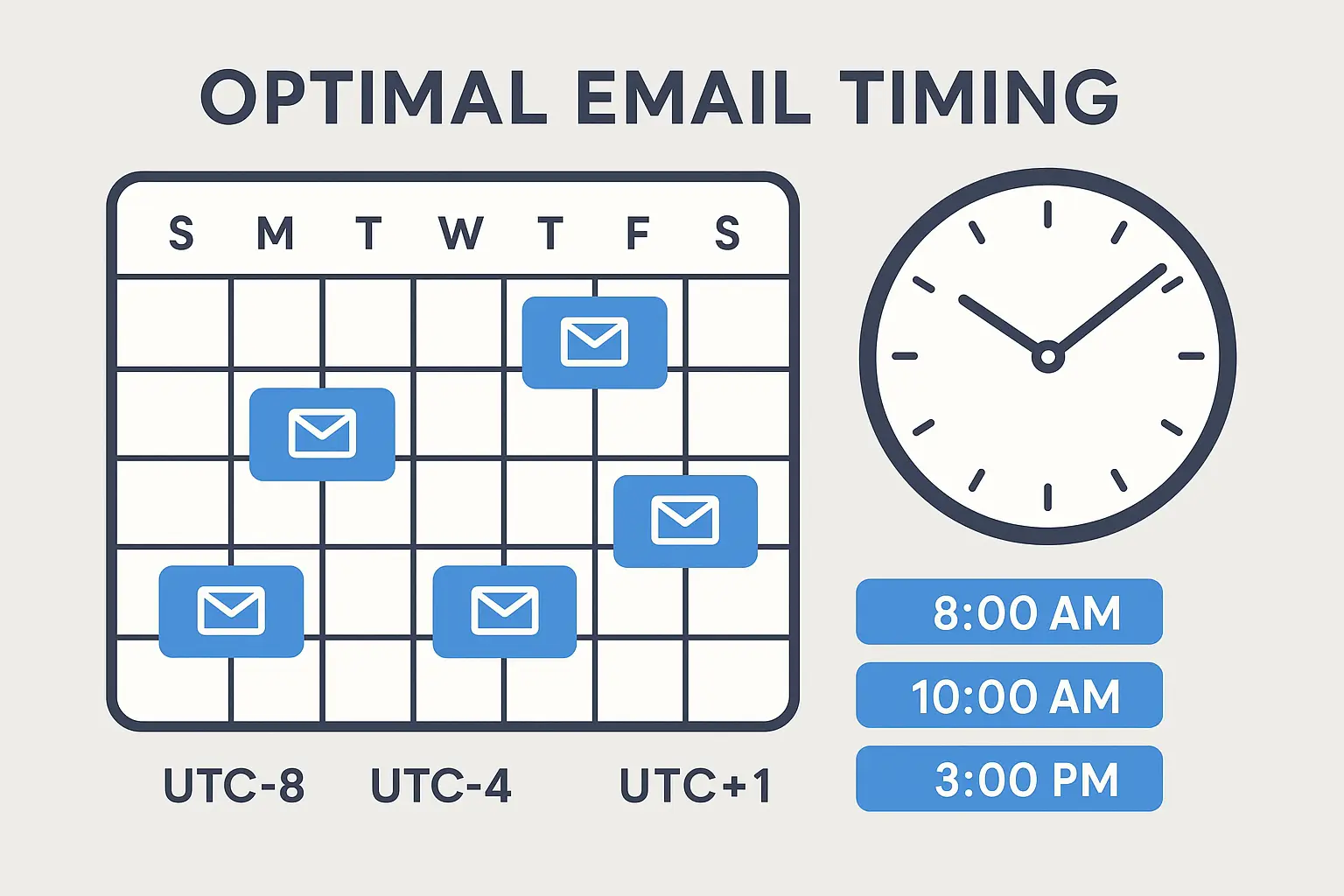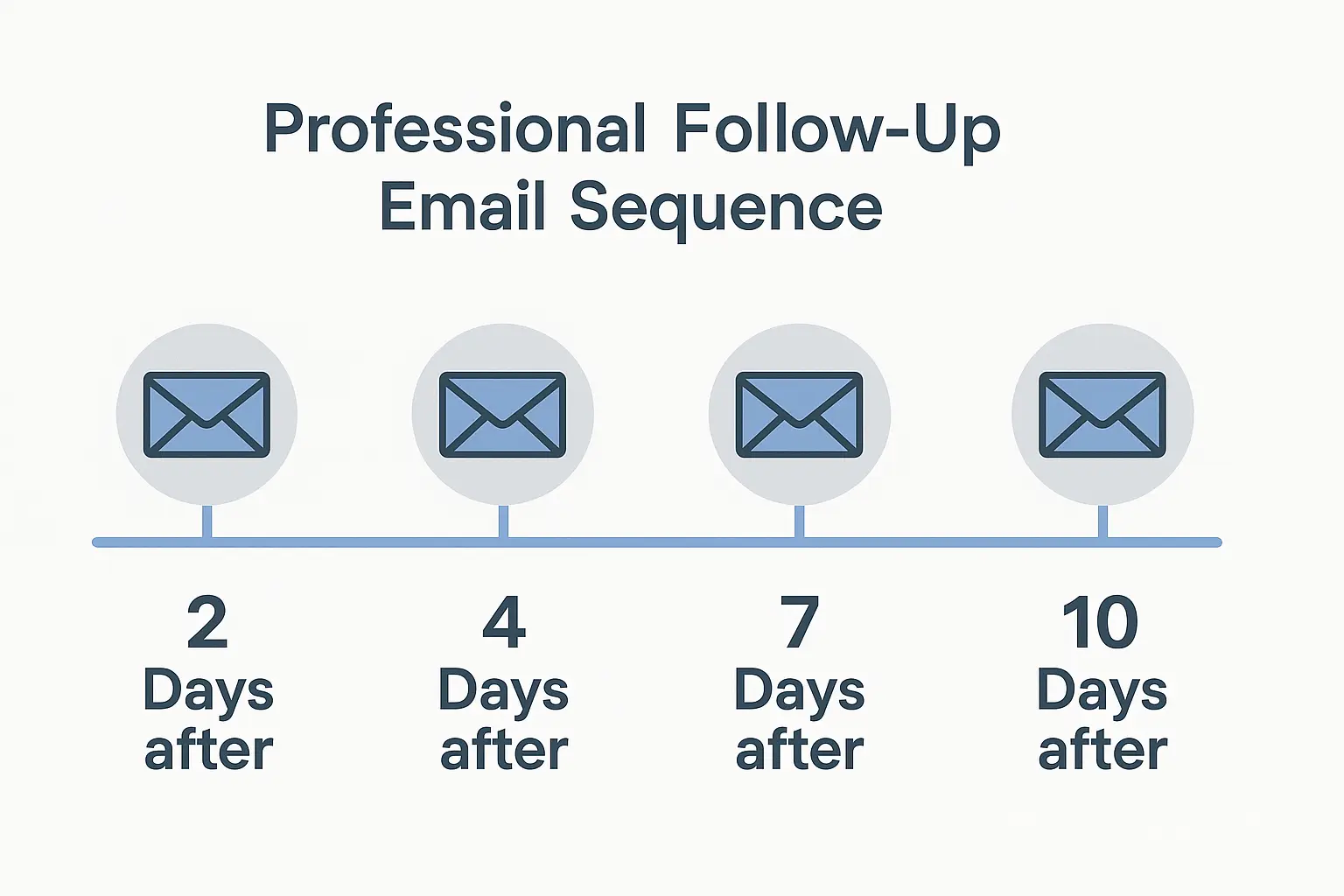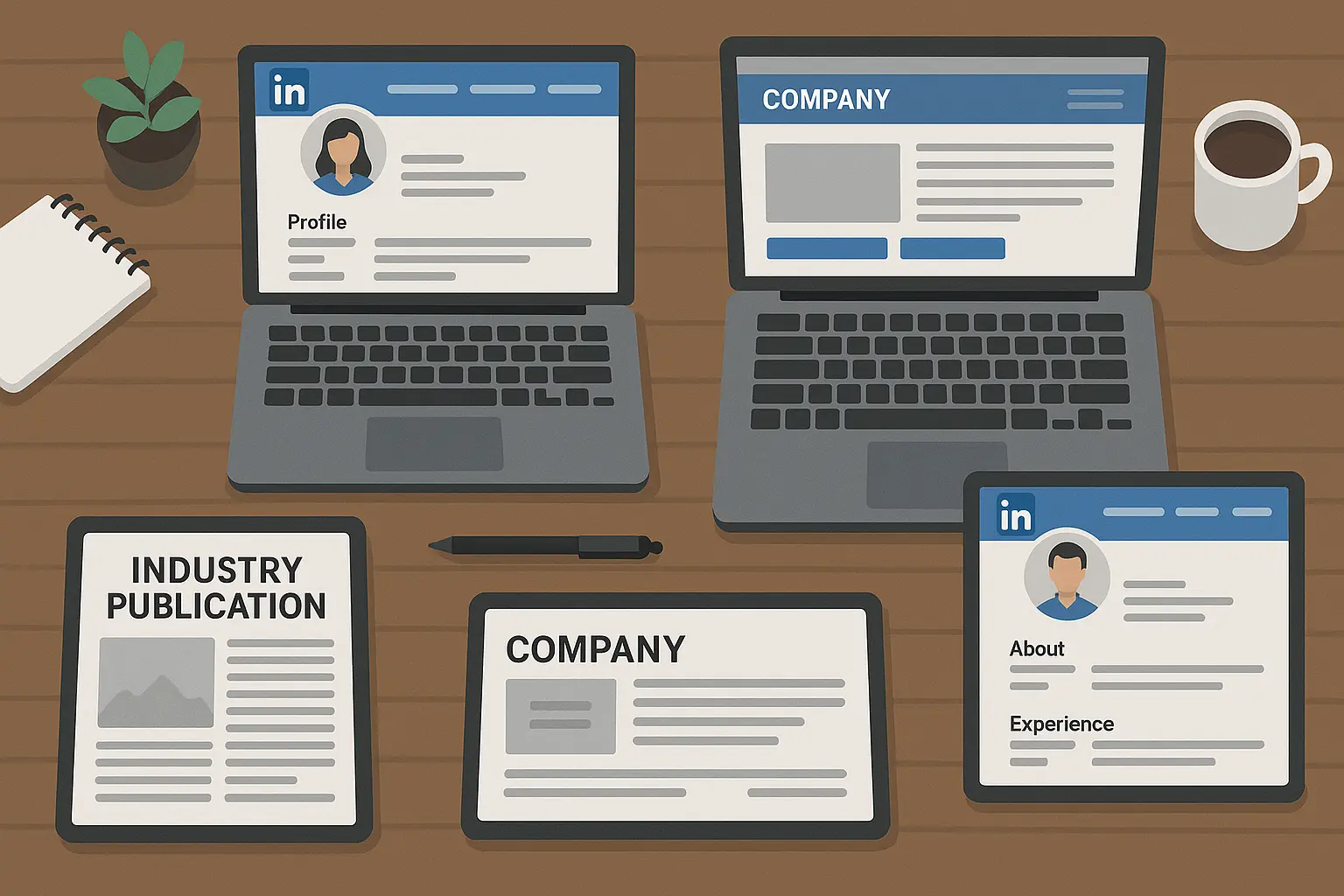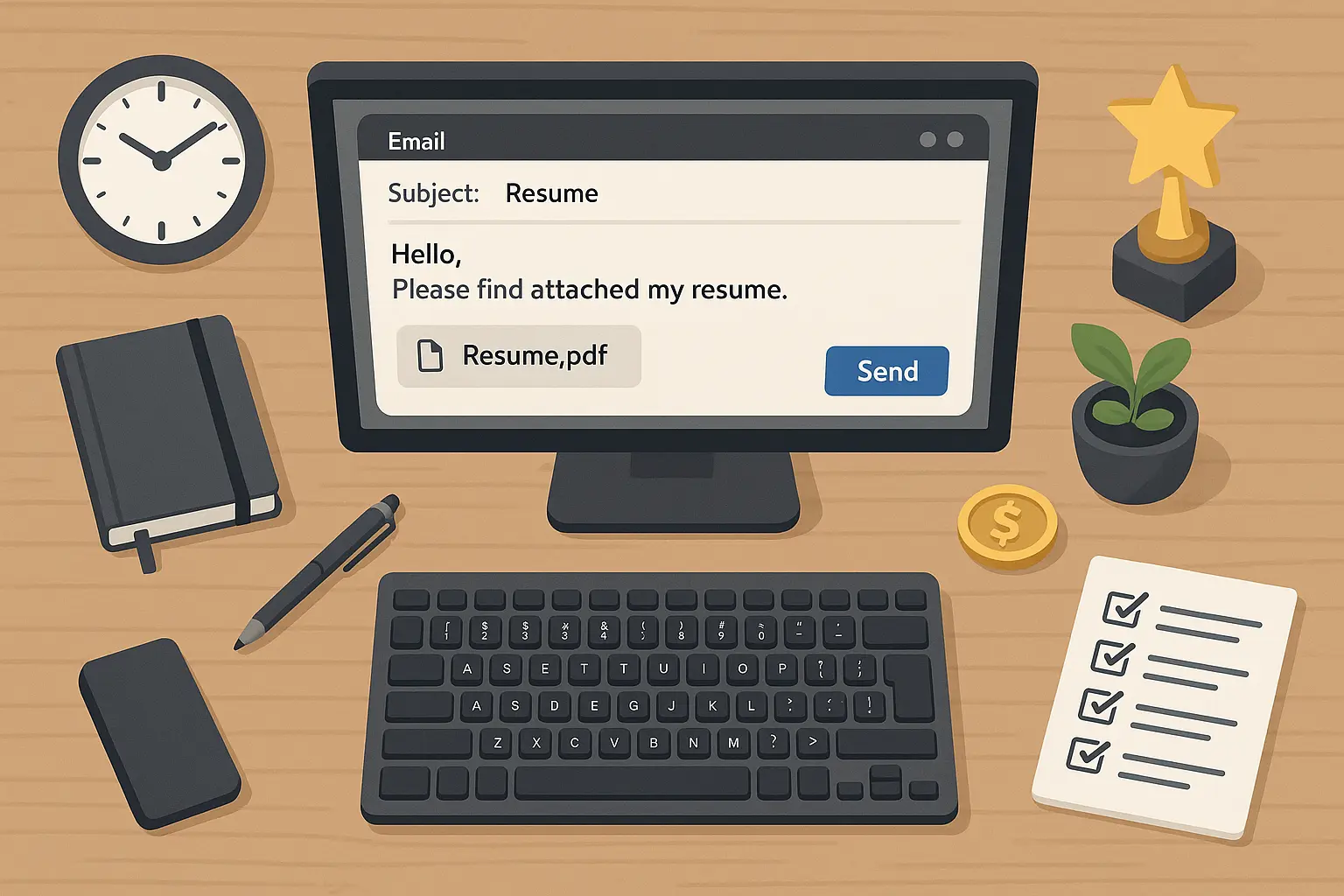How to Email a Resume That Actually Gets You Hired (Without Looking Desperate)
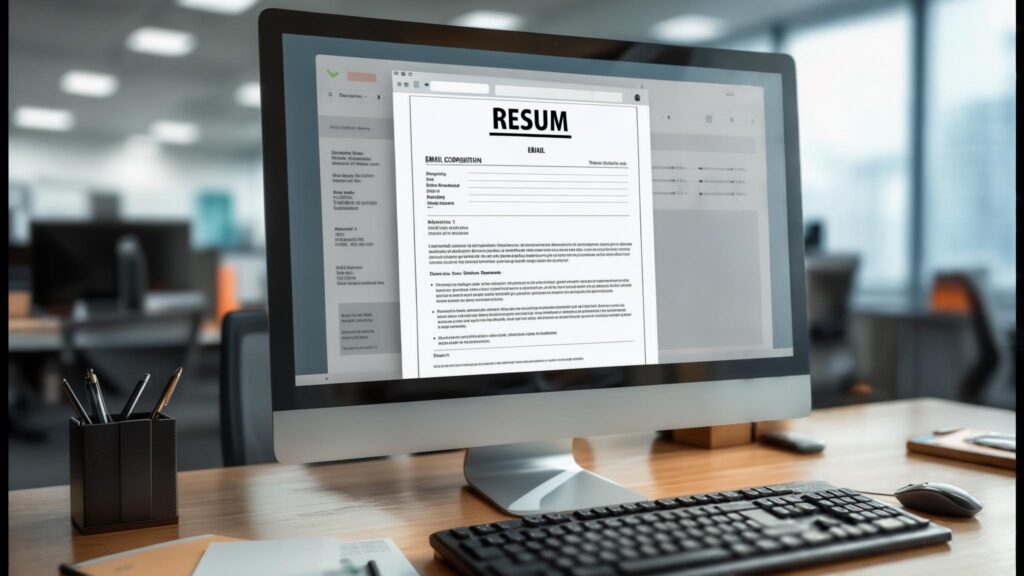
Here’s the thing nobody tells you about job applications: your resume could be perfect, but if your email sucks, it’ll never get read. According to AIApply research, the average job posting receives approximately 250 applications, which means your carefully crafted resume is drowning in a sea of generic emails.
The secret isn’t having the best qualifications—it’s knowing how to present them in a way that makes busy recruiters actually want to open your email. This guide breaks down everything from writing subject lines that get noticed to timing your emails perfectly, helping you turn what feels like shouting into the void into real conversations with potential employers.
Table of Contents
-
Email Composition That Makes Hiring Managers Pay Attention
-
Technical Setup That Prevents Your Resume From Getting Lost
-
Timing and Follow-Up Strategies That Show Persistence Without Annoyance
-
Advanced Research Techniques That Set You Apart From Generic Applications
TL;DR
-
Your subject line determines whether your email gets opened—use specific job titles and your name for maximum impact
-
Keep your email body to three sentences max: hook them, show your value, and close professionally
-
Always send PDFs unless specifically asked for Word documents, and name your files properly
-
Tuesday through Thursday, 10 AM to 2 PM in their time zone gives you the best shot at being seen
-
Wait one week before your first follow-up, then space subsequent emails 10-14 days apart
-
Research the company and hiring manager on LinkedIn to personalize your approach authentically
Email Composition That Makes Hiring Managers Pay Attention
Writing an effective resume email is completely different from other professional communications. You’re not writing a novel—you’re creating a preview that grabs attention immediately while providing just enough information to make someone want to learn more about you.
The challenge is striking the right balance between being informative and being concise. Research shows that a surprising 3 in 10 resumes are rejected solely due to unprofessional email addresses, according to AIApply. This means your email setup can eliminate you from consideration before anyone even reads your qualifications.
Understanding the fundamentals of professional resume format helps ensure your attached document matches the quality of your email communication.
Subject Lines That Actually Get Your Emails Opened
Your subject line is doing all the heavy lifting before anyone even sees your qualifications. Skip the creative attempts and clever wordplay—hiring managers don’t have time for riddles when they’re sorting through hundreds of applications.
The goal is to be immediately clear about who you are and what you want while giving the recipient a reason to prioritize your email over the dozens of others they receive daily.
|
Subject Line Type |
Example |
Why It Works |
|---|---|---|
|
Basic Formula |
“Application for Marketing Manager – John Smith” |
Clear, searchable, professional |
|
With Qualifier |
“Experienced CPA – Senior Accountant Application – Jane Doe” |
Adds relevant credential upfront |
|
Skill-Focused |
“Python Developer Application – Mike Johnson” |
Highlights key technical skill |
|
Certification |
“PMP Certified Project Manager – Sarah Wilson” |
Shows specific qualification |
|
Department-Specific |
“Sales Manager Position – Regional Experience – Tom Brown” |
Indicates relevant background |
Job-Specific Formulas That Work Every Time
The most effective subject lines follow proven templates that hiring managers can quickly scan and understand. “Application for [Position Title] – [Your Name]” works because it’s direct and searchable in their inbox later. “Experienced [Your Profession] Seeking [Position Title]” adds a qualifier that immediately communicates your level.
These aren’t exciting, but they get results because they make the recruiter’s job easier. For a marketing coordinator position, “Marketing Coordinator Application – Jennifer Martinez” is straightforward and professional. For someone with specialized experience, “Digital Marketing Coordinator – 5 Years SaaS Experience – Jennifer Martinez” provides additional context that could make the difference in getting opened first.
Adding Unique Qualifiers Without Sounding Unprofessional
Once you’ve mastered the basic formula, you can enhance your subject lines with specific qualifications that make you stand out. Adding “CPA” or “10+ Years Experience” or “Bilingual” gives hiring managers additional context about why they should open your email first.
The trick is choosing qualifiers that directly relate to the job requirements—don’t just list random credentials that might confuse rather than clarify your fit for the role.
Writing Email Body Content That Gets Results
Your email body isn’t a cover letter, and it’s definitely not a summary of your resume. Think of it as a movie trailer—you have maybe 30 seconds of someone’s attention to make them care enough to open your attachment.
Every sentence needs to earn its place, and every word should move you closer to getting that interview invitation. Studies indicate 75% of HR managers admit to catching inaccuracies on resumes, while 64.2% of Americans confess to embellishing their resumes, according to AIApply research. This highlights why authenticity in your email communication is crucial for building trust from the start.
Your email content should complement your resume cover letter secrets by providing a concise preview of the value you bring to the role.
Opening Lines That Hook Recruiters Immediately
Skip the generic “I am writing to express my interest” openings that make recruiters’ eyes glaze over. Instead, start with something that shows you’ve done your homework: “I noticed your recent expansion into the Denver market and would love to discuss how my experience opening three new territories could support your growth plans.”
Reference where you found the job posting, mention a mutual connection, or highlight something specific about the company that caught your attention. That opening line determines whether they keep reading or move on to the next application.
Your Value Proposition in Three Sentences Max
This is where you prove you understand what they need and can deliver it. Sentence one should highlight your most relevant achievement with numbers if possible. Sentence two demonstrates you understand their challenges or goals. Sentence three connects your skills directly to their needs.
For example: “I increased sales by 40% in my current role by implementing a new client retention strategy. I understand you’re looking to improve customer lifetime value in a competitive market. My experience with data-driven retention programs could help you achieve similar results.”
Professional Closings That Invite Response
End your email with gratitude and enthusiasm, but avoid sounding desperate or pushy. “Thank you for considering my application. I’d welcome the opportunity to discuss how my experience could contribute to your team’s success” strikes the right tone.
Include your phone number even though it’s in your signature—make it as easy as possible for them to reach you. Express genuine interest in next steps without demanding immediate action.
Sample Templates You Can Actually Use
Having templates gives you a starting point, but the magic happens in the customization. These aren’t meant to be copied word-for-word—they’re frameworks that you can adapt based on your experience level, the specific role, and what you’ve learned about the company.
The best emails feel personal and tailored, even when they’re built on a proven structure.
Entry-Level Professional Template That Works
When you’re just starting out, focus on potential rather than extensive experience. Highlight relevant coursework, internships, projects, and transferable skills from other contexts.
Entry-level candidates can benefit from understanding resume no experience guide strategies to present their potential effectively in both their resume and email communication.
Here’s a complete entry-level template that actually sounds human:
“Subject: Marketing Coordinator – Recent Grad – Alex Chen
Hi there,
Just graduated with a business degree and spent last summer helping two startups boost their social media engagement by 45%. Saw your marketing coordinator opening and think my fresh perspective on digital strategy could help with your upcoming product launch.
Would love to chat about how I can contribute to your team.
Best,
Alex Chen | (555) 123-4567″
Experienced Professional Template That Gets Attention
With years of experience under your belt, you can be more specific about achievements and strategic thinking. Here’s what works:
“Subject: Senior Project Manager – 8 Years Experience – Sarah Wilson
Hi [Hiring Manager Name],
In my eight years managing complex implementations, I’ve delivered 15+ projects on time and under budget, including a $2M system upgrade that improved operational efficiency by 35%. Your recent announcement about digital transformation caught my attention—my track record of translating business requirements into actionable results could help you achieve those goals.
Happy to discuss how my experience aligns with your needs.
Best regards,
Sarah Wilson | (555) 987-6543″
Technical Setup That Prevents Your Resume From Getting Lost
The technical side of emailing resumes might seem boring, but it’s where a lot of good candidates accidentally eliminate themselves from consideration. Getting these details right doesn’t guarantee you’ll get the job, but getting them wrong can definitely cost you the opportunity.
Understanding ATS-friendly resume secrets ensures your attached resume will be properly processed by applicant tracking systems after your email gets through.
Recent cybersecurity incidents highlight the importance of technical reliability in professional communications. The South Lyon Community School District experienced a three-day closure due to cybersecurity issues Click On Detroit, demonstrating how technical disruptions can impact professional operations and why having reliable, secure email practices matters more than ever.
Email Account and Signature Optimization
Your email setup communicates professionalism before anyone reads a single word of your message. Everything from your email address to your signature contributes to the first impression you’re making.
These might seem like small details, but they add up to create an overall sense of whether you’re someone who pays attention to professional standards and takes the application process seriously.
Professional Email Address Guidelines That Matter
Use firstname.lastname@gmail.com—it’s the gold standard. Avoid numbers unless absolutely necessary (and if you must use them, make them meaningful like your graduation year, not random digits).
Never use nicknames, inside jokes, or anything that might make a hiring manager question your judgment. If your name is already taken, try adding your middle initial or a period between first and last name.
Professional Email Address Checklist:
-
Uses your actual first and last name
-
Avoids numbers, unless meaningful (graduation year)
-
No nicknames or unprofessional references
-
Uses a reputable email provider (Gmail, Outlook, etc.)
-
Easy to spell and remember
-
Matches the name on your resume
Email Signature Best Practices
Keep your signature clean and informative without going overboard. Include your full name, phone number, professional email address, and LinkedIn profile URL.
Skip the inspirational quotes, multiple colors, or large images that might not display properly on all devices. Your signature should make it easy for someone to contact you through their preferred method—that’s it.
File Management and Attachment Strategy
How you handle your resume file can make or break your application before anyone even looks at your qualifications. Proper file naming, format selection, and size management show attention to detail while ensuring your resume actually reaches the intended recipient in a readable format.
File Naming Conventions That Make Sense
Name your resume file something that makes it easy to find and identify later. “FirstName_LastName_Resume_2024.pdf” or “LastName_FirstName_PositionTitle.pdf” work well because they’re immediately clear and searchable.
Avoid generic names like “Resume.pdf” or “MyResume.pdf” that tell the recipient nothing useful. Remember, hiring managers often save dozens of resumes to review later—make yours easy to locate in their downloads folder.
PDF vs. Word Document Considerations
PDF is usually your best bet because it preserves your formatting across different devices and operating systems. Your carefully designed resume will look exactly the same whether it’s opened on a Mac, PC, or mobile device.
However, some companies specifically request Word documents (often because their ATS systems work better with them), so be prepared to provide both formats. When in doubt, go with PDF unless explicitly told otherwise.
Plain Text
|
File Format |
Pros |
Cons |
Best Use Case |
|---|---|---|---|
|
|
Preserves formatting, universal compatibility, professional appearance |
Some ATS systems struggle with complex layouts |
Default choice for most applications |
|
Word (.docx) |
ATS-friendly, easy to edit, widely accepted |
Formatting can change across devices |
When specifically requested |
|
Perfect ATS compatibility, loads quickly |
No formatting, looks basic |
ATS-heavy companies only |
|
|
Google Docs Link |
Always current version, collaborative |
Requires internet, less professional |
Internal referrals only |
File Size and Compatibility Checks
Keep your resume file under 2MB to avoid email delivery issues—most email systems will reject larger attachments. Test your file by opening it on different devices to make sure everything displays correctly.
Check that your fonts are embedded properly and that any graphics or formatting elements appear as intended. Send yourself a test email from a different account to see exactly what the recipient will receive.
Before sending your resume to a potential employer, test it by emailing yourself from a different account. Open the attachment on both your computer and phone to ensure formatting stays intact. One candidate discovered their resume’s custom fonts weren’t displaying properly on mobile devices—an issue they caught and fixed before applying to their dream job.
Timing and Follow-Up Strategies That Show Persistence Without Annoyance
When you send your resume email can be just as important as what you write in it. Timing affects whether your message gets seen, how quickly you get a response, and how your follow-up efforts are perceived.
There’s a fine line between being persistent and being annoying—and that line is usually defined by timing, frequency, and the value you provide in each interaction.
Optimal Sending Times and Days
Hiring managers and recruiters are people with predictable work patterns, and understanding those patterns can give you a significant advantage. Sending your resume when they’re most likely to be focused and receptive increases your chances of getting noticed and prioritized.
Weekly Timing Strategy
Tuesday through Thursday are your sweet spot for resume emails. Monday mornings are usually overwhelming as people catch up from the weekend, and Friday afternoons find everyone mentally checked out and planning for the weekend. Mid-week days give you the best chance of reaching someone when they’re focused on work but not completely swamped.
If you’re applying for a role that starts immediately, don’t wait for the “perfect” day—but if you have flexibility, aim for the middle of the week.
Daily Timing Considerations
Send your emails between 10 AM and 2 PM in the recipient’s time zone. This window catches people after they’ve handled their morning priorities but before the afternoon energy crash hits. Avoid early morning emails (people are catching up on urgent items) and late afternoon sends (attention is shifting to wrapping up the day).
If you’re applying across time zones, do the math—it shows consideration and attention to detail.
Professional Follow-Up Protocol
Following up on your resume email requires strategy and restraint. You want to stay top-of-mind without becoming a nuisance, demonstrate continued interest without appearing desperate, and add value with each interaction rather than just repeating your initial request.
Effective follow-up strategies can be enhanced by understanding follow-up after interview techniques that maintain professional momentum throughout the hiring process.
Professional communication has become even more critical in today’s environment. Recent incidents like the alarming email that caused a high school lockdown in Lake Villa Lake McHenry Scanner remind us that email communication tone and content are scrutinized more carefully than ever, making professional follow-up etiquette essential.
First Follow-Up Timeline
Wait one full week after your initial email before sending your first follow-up. This gives the recipient time to review applications and shows you understand they have other priorities. Your follow-up should acknowledge that you know they’re busy, reiterate your interest in the specific role, and mention any new developments in your background since your original application.
Keep it brief and add something new rather than just restating your original message.
First Follow-Up Checklist:
-
Wait exactly 7 days from initial application
-
Reference your original application date
-
Add new information (certification, project, etc.)
-
Keep it under 100 words
-
Maintain professional tone
-
Include your phone number again
Subsequent Communication Strategy
Space additional follow-ups 10-14 days apart, and make each one valuable rather than just persistent. Share a relevant industry article with your thoughts, mention a new certification you’ve earned, or reference a recent company announcement that reinforces your interest.
After three total emails (initial plus two follow-ups), it’s usually time to move on unless you receive some indication they’re still considering your application. Quality and timing matter more than quantity.
Advanced Research Techniques That Set You Apart From Generic Applications
The difference between a good resume email and a great one often comes down to how well you’ve researched the company, role, and person you’re contacting. This isn’t about stalking people online—it’s about demonstrating genuine interest and understanding that goes beyond what’s in the job posting.
When you can reference specific company initiatives, industry challenges, or recent achievements, you immediately separate yourself from candidates who are clearly mass-applying to dozens of positions.
Company and Role Research Integration
Effective research transforms a generic job posting into insights about what the company really needs and values. This intelligence should inform every aspect of your email, from the specific achievements you highlight to the language you use to describe your experience.
The goal isn’t to show off how much you know—it’s to demonstrate that you understand their context and can contribute meaningfully to their specific situation.
LinkedIn and Company Website Intelligence
Start with the hiring manager’s LinkedIn profile to understand their background, recent posts, and professional interests. Look for shared connections, similar career paths, or common interests that could provide natural conversation starters.
Check the company’s recent news, press releases, and social media activity to understand their current priorities and challenges. This research should feel natural when woven into your email—not forced or overly detailed.
When applying for a marketing role at a SaaS company, one candidate discovered the hiring manager had recently posted about challenges with customer retention in their industry. They mentioned in their email: “I noticed your recent LinkedIn post about retention challenges in the SaaS space. My experience implementing a customer success program that reduced churn by 25% at my current company might be relevant to your team’s goals.” This specific reference showed they were engaged with their content and could contribute to their actual challenges.
Industry Trend Awareness
Reference relevant industry developments, challenges, or opportunities that relate to the role you’re seeking. This shows you’re engaged with your professional field beyond just looking for a job.
For example, if you’re applying for a marketing role at a retail company, you might mention how recent changes in consumer behavior are creating new opportunities for brands that can adapt quickly. Connect these trends to your experience and how you could help the company navigate them successfully.
Final Thoughts
Stop overthinking it. Your resume email doesn’t need to be perfect—it needs to be clear, professional, and personal enough to show you actually care about this specific job. Every element, from your subject line to your follow-up strategy, should make their job easier while highlighting why you’re worth their time and attention.
The most successful resume emails feel like they’re from real people who understand what the company needs and can deliver it. You’re not just sending a document; you’re starting a professional conversation that could change your career trajectory.
When you’ve mastered the art of email communication, make sure your resume lives up to the expectations you’ve set. Resume Builder IQ’s AI-powered platform helps you create ATS-friendly resumes with industry-specific keywords and professional formatting that hiring managers expect when they open your carefully crafted email. Ready to create a resume that matches your email game? Start building your standout resume today and give yourself the complete package needed to land more interviews.

